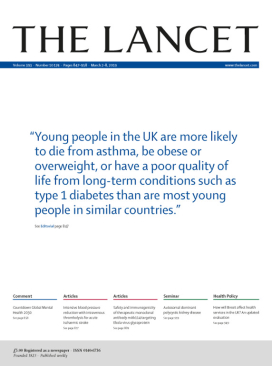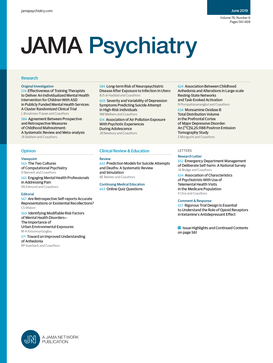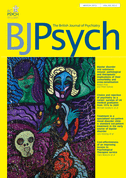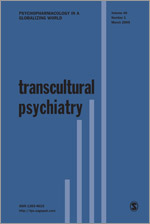
The Lancet is a weekly peer-reviewed general medical journal and one of the oldest of its kind. It is also one of the world's highest-impact academic journals. It was founded in England in 1823.
The Institute for Scientific Information (ISI) was an academic publishing service, founded by Eugene Garfield in Philadelphia in 1956. ISI offered scientometric and bibliographic database services. Its specialty was citation indexing and analysis, a field pioneered by Garfield.

The Zoological Journal of the Linnean Society is a monthly peer-reviewed scientific journal covering zoology published by Oxford University Press on behalf of the Linnean Society. The editor-in-chief is Maarten Christenhusz. It was established in 1856 as the Journal of the Proceedings of the Linnean Society of London. Zoology and renamed Journal of the Linnean Society of London, Zoology in 1866. It obtained its current title in 1969.

The American Journal of Psychiatry is a monthly peer-reviewed medical journal covering all aspects of psychiatry, and is the official journal of the American Psychiatric Association. The first volume was issued in 1844, at which time it was known as the American Journal of Insanity. The title changed to the current form with the July issue of 1921.

JAMA Psychiatry is a monthly peer-reviewed medical journal published by the American Medical Association. It covers research in psychiatry, mental health, behavioral sciences, and related fields. The journal was established as Archives of Neurology and Psychiatry in 1919, and was split into two separate journals in 1959: Archives of Neurology and Archives of General Psychiatry. In 2013, their names changed to JAMA Neurology and JAMA Psychiatry, respectively. The editor-in-chief is Dost Öngür.

Sulpiride, sold under the brand name Dogmatil among others, is an atypical antipsychotic medication of the benzamide class which is used mainly in the treatment of psychosis associated with schizophrenia and major depressive disorder, and is sometimes used in low dosage to treat anxiety and mild depression.

The British Journal of Psychiatry is a peer-reviewed medical journal covering all branches of psychiatry with a particular emphasis on the clinical aspects of each topic.
The Acta Psychiatrica Scandinavica is a Scandinavian peer-reviewed medical journal containing original research, systematic reviews etc. relating to clinical and experimental psychiatry. According to the Journal Citation Reports, the journal has a 2021 impact factor of 7.734. Its editor-in-chief is Ida Hageman.

Biological Psychiatry is a biweekly, peer-reviewed, scientific journal of psychiatric neuroscience and therapeutics, published by Elsevier since 1985 on behalf of the Society of Biological Psychiatry, of which it is the official journal. The journal covers a broad range of topics related to the pathophysiology and treatment of major neuropsychiatric disorders. A yearly supplement is published which contains the abstracts from the annual meeting of the Society of Biological Psychiatry.

The Society for Scientific Exploration (SSE) is a group committed to studying fringe science. The opinions of the organization in regard to what are the proper limits of scientific exploration are often at odds with those of mainstream science. Critics argue that the SSE is devoted to disreputable ideas far outside the scientific mainstream.
Culture, Medicine and Psychiatry is a cross-cultural peer-reviewed medical journal published quarterly by Springer Science+Business Media.

Psychological Medicine is a peer-reviewed medical journal in the field of psychiatry and related aspects of psychology and basic sciences. According to the Journal Citation Reports, the journal has a 2020 impact factor of 7.723.

The Journal of Autism and Developmental Disorders is a monthly peer-reviewed medical journal covering research on all aspects of autism spectrum disorders and related developmental disabilities. The journal was established in 1971 as the Journal of Autism and Childhood Schizophrenia, obtaining its current title in 1979. It is published by Springer Science+Business Media and the editor-in-chief is Lynn Kern Koegel.
The Journal of Clinical Psychiatry is a peer-reviewed medical journal that covers clinical psychiatry, especially depression, bipolar disorder, schizophrenia, anxiety, addiction, and attention-deficit/hyperactivity disorder, as well as several other mental disorders. It is the official journal of the American Society for Clinical Psychopharmacology and was established in 1940 as Diseases of the Nervous System, before obtaining its current name in 1979.

Transcultural Psychiatry is a peer-reviewed academic journal that publishes papers in the fields of cultural psychiatry, psychology and anthropology. The journal's editor-in-chief is Laurence J. Kirmayer. The Associate Editors are Renato Alarcón, Roland Littlewood and Leslie Swartz. It has been in publication since 1964 and is currently published by SAGE Publications on behalf of the Division of Social and Transcultural Psychiatry of McGill University. It is the official journal of the World Psychiatric Association Transcultural Psychiatry Section and is also published in association with the Society for the Study of Psychiatry and Culture.
Australian and New Zealand Journal of Psychiatry is a peer-reviewed academic journal that publishes papers in the field of Psychiatry. The journal's editor is Professor Gin S. Malhi. It is currently published by SAGE Publications on behalf of the Royal Australian and New Zealand College of Psychiatrists.
European Neuropsychopharmacology is a monthly peer-reviewed scientific journal published by Elsevier. It is the official journal of the European College of Neuropsychopharmacology. It was established in November 1990 and covers clinical and basic research relevant to the effects of centrally acting agents in its broadest sense.
The Journal of Psychiatry & Neuroscience is a bimonthly open access peer-reviewed scientific journal covering research in psychiatry and neuroscience concerning the mechanisms involved in the etiology and treatment of psychiatric disorders. The journal was established in 1976 as the Psychiatric Journal of the University of Ottawa and obtained its current title in 1991. It is published by the Canadian Medical Association and the current (2021) editors-in-chief are Paul Albert and Lena Palaniyappan.
Progress in Neuro-Psychopharmacology & Biological Psychiatry is a peer-reviewed academic journal publishing review articles and original research reports pertaining to neuropsychopharmacology and biological psychiatry.

Psychiatry and Clinical Neurosciences (PCN) is a bimonthly peer-reviewed medical journal covering psychiatry and neuroscience. It was established in 1933 as Folia Psychiatrica Et Neurologica Japonica, and was renamed The Japanese Journal of Psychiatry and Neurology in 1986. It obtained its current name in 1995. It is published by John Wiley & Sons on behalf of the Japanese Society of Psychiatry and Neurology(JSPN), of which it is the official journal. The editors-in-chief are Shigenobu Kanba (Kyushu University) and Tadafumi Kato (RIKEN Brain Science Institute,Juntendo University). According to the Journal Citation Reports, the journal has a 2021 impact factor of 12.145, ranking it 14th out of 155 journals in the category "Psychiatry" and 16th out of 274 in the category "Neurosciences". PCN's mission is to become an international academic hub of psychiatry as well as a leading journal in the East disseminating prominent research which are valuable to the psychiatry field. PCN is published 12 online issues a year by JSPN in all fields of psychiatry and related neurosciences in the following categories: Review Articles, Regular Articles, and Letters to the Editor.











